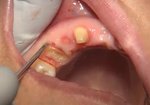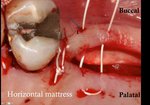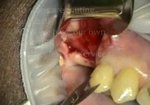
Video Player is loading.
Current Time 0:00
/
Duration 0:00
Loaded: 0%
Stream Type LIVE
1x
- 0.5x
- 0.75x
- 1x, selected
- 1.25x
- 1.5x
- 1.75x
- 2x
- Chapters
- descriptions off, selected
- captions settings, opens captions settings dialog
- captions off, selected
This is a modal window.
Beginning of dialog window. Escape will cancel and close the window.
End of dialog window.
10 seconds
Playback speed
This is a modal window. This modal can be closed by pressing the Escape key or activating the close button.
663 views
August 6, 2017
Most dental practitioners fail to recognize that the TMJ orthopedic condition intimately influences the occlusion. ...
read more ↘ The soft tissue TMJ disks are not readily visualized with standard protocols and imaging, including CBCT. MRI imaging is necessary to objectively determine the condition, position, and degree of herniation of the disks. Given the asymmetrical thickness of the various parts of the disk, anterior displacement readily changes how the condylar head relates to the glenoid fossa. Given that the mandibular dentition is connected to the mandible, this readily alters the spatial relationship between the upper and lower teeth (posterior band is thicker than intermediate zone, for instance). The CNS senses this change through proprioceptive inputs relayed via both trigeminal and sympathetic inputs with a resultant heightened efferent muscular response, leading to hyperactivity of the muscles of mastication to tip, break, intrude teeth in bone, or whatever it takes, to reestablish a more balanced occlusion, with potentially catastrophic consequences in the dentition (such as breaking teeth and failed restorative work). It turns out that usually the dentition is the most readily adaptable part of the system, not the TMJ's, hence the restorative fails...
A discussion between the patient and Dr. Nick is documented regarding these likelihoods. Dr. Nick will order and interpret TMJ MRI's for her before her next visit, in an objective attempt to understand not only if the disks are displaced, but also specifically the condition, position, and degree of herniation of both the lateral and medial poles of her disks. Why? Because the condition, position, and degree of herniation of the two halves of the disks has a massive influence as to how her occlusion is affected. Then and only then, after proper diagnosis of her TMJ condition bilaterally, will an attempt be made to replace her failing dental work. Her treatment plan will vary depending upon what exactly is wrong... To learn more: CNOtmj.com.
↖ read less
read more ↘ The soft tissue TMJ disks are not readily visualized with standard protocols and imaging, including CBCT. MRI imaging is necessary to objectively determine the condition, position, and degree of herniation of the disks. Given the asymmetrical thickness of the various parts of the disk, anterior displacement readily changes how the condylar head relates to the glenoid fossa. Given that the mandibular dentition is connected to the mandible, this readily alters the spatial relationship between the upper and lower teeth (posterior band is thicker than intermediate zone, for instance). The CNS senses this change through proprioceptive inputs relayed via both trigeminal and sympathetic inputs with a resultant heightened efferent muscular response, leading to hyperactivity of the muscles of mastication to tip, break, intrude teeth in bone, or whatever it takes, to reestablish a more balanced occlusion, with potentially catastrophic consequences in the dentition (such as breaking teeth and failed restorative work). It turns out that usually the dentition is the most readily adaptable part of the system, not the TMJ's, hence the restorative fails...
A discussion between the patient and Dr. Nick is documented regarding these likelihoods. Dr. Nick will order and interpret TMJ MRI's for her before her next visit, in an objective attempt to understand not only if the disks are displaced, but also specifically the condition, position, and degree of herniation of both the lateral and medial poles of her disks. Why? Because the condition, position, and degree of herniation of the two halves of the disks has a massive influence as to how her occlusion is affected. Then and only then, after proper diagnosis of her TMJ condition bilaterally, will an attempt be made to replace her failing dental work. Her treatment plan will vary depending upon what exactly is wrong... To learn more: CNOtmj.com.
↖ read less
Comments 8
Login to view comments.
Click here to Login




















